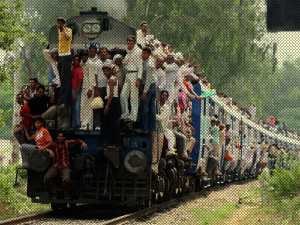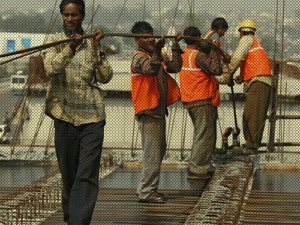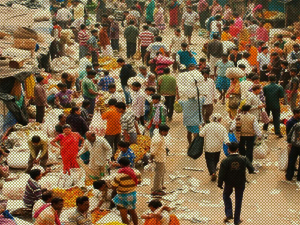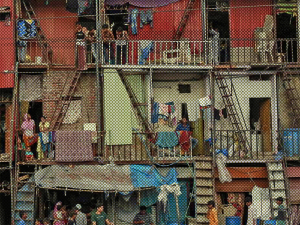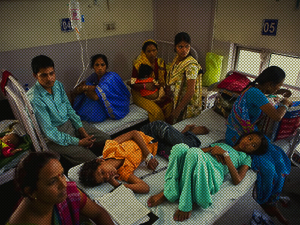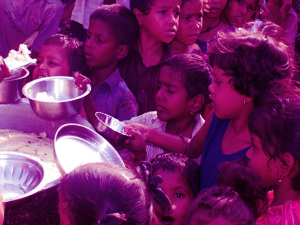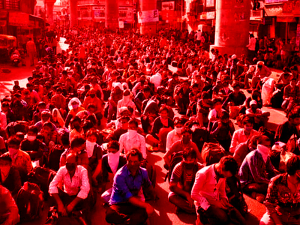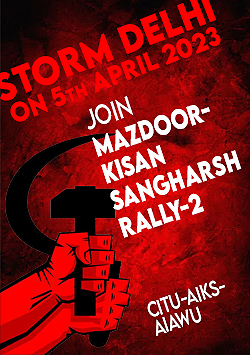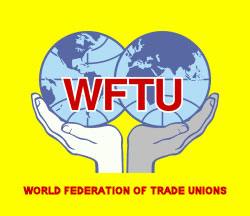Super User
Railways : Claims and Reality
Claims
Modi in December 2014 - ‘I want to make it clear that we are not privatising Railways. We cannot go in this direction’
Modi in March 2024, while inaugurating and laying the foundation stones of several railway projects and flagging off ten Vande Bharat trains on the same day - ‘The foundation stone laying that happened today has come with the guarantee of your bright future’…‘Today I am giving a guarantee to the nation that in the next five years, Indian Railways will see such a transformation which no one would have imagined’
Reality
Privatisation:
In 2015, Bibek Debroy committee, constituted by Modi government recommended unbundling of the Indian Railways to facilitate piecemeal privatisation and also merging of Railway Budget with Union Budget.
Modi government started implementing them. Since 2017, the railway budget has been merged with the union budget. The government started splitting Indian Railways horizontally and vertically so private corporates can grab the pieces easily. It ignored the danger that lack of synchronisation between the various activities handed over to different private entities, would pose to the smooth running of trains and safety of passengers. It announced 100% FDI in almost all the activities performed by Indian Railways – construction, operations, maintenance, rolling stock, dedicated lines, train sets etc. Major activities like cleaning, maintenance works, ticketing etc have been outsourced to private players. It started privatisation of railway stations in the name of private participation in station development.
The 100 day action plan of the Indian Railways, after Modi returned to power in 2019, included corporatisation of the production units and other services, to facilitate their privatisation
National Monetisation Pipeline (NMP)
NMP is meant for handing over public infrastructure at throwaway prices to private corporates. Railway assetsincluding railway stations, passenger trains, railway tracks, goods sheds, etcare leased out to private companies on a long term basis.Thus control of assets is transferredto private companies for an indefinite period, which is nothing but privatisation.
The move to privatise goods sheds would impact not only the loading and unloading workers but also public control over land and the prices of commodities. With dedicated freight corridors built with public money being handed over to private players, private profits would become the priority over public welfare. Freight traffic today contributes 65% of revenue for the Indian Railways. Privatisation of this cost effective mode of transport would lead to loss of revenue to the Railways as well as endanger livelihood of thousands of people
Vande Bharat trains:
Production
Our production units have the expertise in producing diesel and electric locomotives and rail coaches. Integral Coach Factory in Chennai designed and manufactured the Vande Bharat express. But in April 2022, Indian Railways invited private bids for production of Vande Bharat trains as well as for their maintenance.
The decision to award the maintenance contracts for Vande Bharat trains will affect the functioning of the carriage and wagon repair and maintenance units and workshops across various zones employing 5.5 lakh workers. This is certainly going to destroy our indigenous capacity and leadto job losses.
Conditions of workers
The contract workers employed who provide basic services in the more than 50 Vande Bharat trains running today travel back to back for over 20 hours. But they are denied of minimum wages, over time payment, social security like PF, ESI etc and even resting place in the coaches. They are under the perpetual threat of losing their jobs if they raise their voice or try to get organised into unions.
More than 5 lakh contract workers, most of them young, are working in the Railways. Though the contractors are obliged to pay minimum wages and other statutory benefits to the contract workers as per the agreement they enter into with the government, all these are denied to the contract workers. The contractors siphon off workers’ legitimate earnings and loot hundreds of crores of rupees from the exchequer every year.
Bright future for the youth:
Indian Railways was one of the avenues that provided secure jobs to the youth of our country. But, the number of permanent employees in the Railways has declined by more than 1.5 lakh between 2015 and 2023. More than 3 lakh posts are lying vacant including in safety categories. In the name of austerity, posts are being abolished.
Transformation of the Railways
The Railways, which is now cheapest mode of transport available to the people, particularly the poor, will no more remain so, if the Modi government’s policies are allowed to continue. The last few years had shown this.
The redeveloped stations do not have any space for the poor passengers. Free waiting rooms are replaced by paid lounges. Platform tickets have become unaffordable.
General compartments are fast dwindling in numbers and are being replaced by AC coaches. Halts of passenger trains at smaller stations with low revenue are being abolished. Dynamic fares are introduced. Concessions for senior citizens, persons with disabilities, cancer patients, students etc have been abolished.
Spaces near the railway stations where the poor autorickshaw and rickshaw drivers used to park their vehicles are handed over to big private players in the name of ‘development’. Hundreds of thousands of them are losing their income. Poor passengers are losing cheap affordable transport to and from the railway stations.
Passenger trains are being detained to allow Vande Bharat trains to pass resulting in huge difficulties to the common passengers and dislocation of their routines. Private train operators will be allowed to fix prices, decide services and routes of the trains run by them.
It is clear that the Modi led BJP government is working for the ‘vikas’ of the big Corporates and ‘vinash’ of the common people. It cannot be allowed to continue
Use your vote. Defeat the BJP and its allies to free the country from the regime thatguarantees loot and plunder by the corporates; to save the Railways and the nation
‘Make in India’, Boost to Manufacturing and Job Creation!!! : CLAIMS Vs REALITY
CLAIMS:
Prime Minister Narendra Modi: Production Linked Incentive (PLI) Scheme will boost manufacturing, giving opportunities to youth while making India a preferred investment destination.
Union Minister for Commerce & Industry, Piyush Goyal: PLI revolutionising Make in India will help create jobs, promote exports & make India the factory of the world.
Nirmala Sitaraman, Union Finance Minister, Union Budget 2019-20: PLI of Rs.1, 97,291crores to the manufacturing sector over 5 years for the industries in 14 sectors shall strengthen the manufacturing sector in India, raising share in GDP to 25%, create national manufacturing champions and 60 lakh new jobs and additional production worth of 30 lakhs crores.
Claim was “the scheme shall localise manufacturing, substitute imports, transform export basket from traditional commodities to high value added products, attract investment in core competency & cutting edge technology, impact MSME’s positively”.
REALITY:
Scheme for Promotion of manufacturing Electronics Components & Semiconductors (SPECS) with Rs.76000 crores outlay provides financial incentive of 25% of the company’s capital expenditure. Tatas, Muregappa Group, Micron, and CG, multinational companies from Japan, Thailand and Taiwan setting up semiconductor plants at Sanand, Gujarat and at Assam are given Rs.59000 crores.
In addition to such direct funding, Remission of Duties or Taxes on Export Product (RoDTEP) under Merchandise exports from India Scheme (MEIS) provides for reimbursement of taxes/duties paid by the companies.
But, there are no jobs created, no import substitution, no transformation in export basket, and no investment in core competency & cutting edge technology. Only money flowed from national exchequer to private corporate to boost their profit.
MSME’s are not positively impacted. PLI approved 176 MSME’s as outsource vendors/On-Site Suppliers of Corporates reduce the cost of component production/purchase cost, doubling the PLI benefit to the Corporates.
25% of the cost of capital investment through SPECS, then cost of production through PLI & reimbursement of taxes & duties paid on exports are reimbursed through RoDTEP.
Thus, the Modi government is subsidising and directly funding private capital through an unseen pipeline in the form of the PLI and other schemes that drain the public exchequer to the Corporates. Make in India and job creation are just ‘jumlas’ to deceive the people, particularly the young who are desperately looking for jobs. It is atrocious anti national loot & plunder of public money by the big corporates.
Jobs:
There are 1000 approved companies under the Scheme but jobs in these companies have stood stagnant or decreased e.g. in Wistron(infamous for non adherence to labour statutes & violence at factory), vendor of Foxconn, contract manufacturer for Apple has only 2520 employees.
Among the PLI-beneficiaries, Automobile & Auto Components have laid off 3.5 lakhs since April 2019; Maruti Suzuki reduced its temporary workforce by about 6%. Ashok Leyland, Tata Motors, Eicher, Mahindra & Mahindra, Kia India Pvt ltd, Toyota Kirloskar, Mitsubishi –approved Original Equipment Manufacturers (OEMs) & BOSCH and other approved Auto components manufacturers for PLI have pushed the regular employees out of jobs through forced VRS and other means.
The approved beneficiaries of Food processing industries like Britannia, Parle, Anmol, Haldirams, and ITC foods, MTR foods, Hutsun and others too have not added to the number of employees.
In metals & Minerals for specialty steel approved applicants Jindal, Tata, Arcelormittal-Nippon, Bhushan, JSW, Kirloskar Ferrous, Kalyani, LLYOD no increase in employment is visible.
But production has increased through increased productivity norms imposed on the workers.The share of contract workers has increased to 42.5% in 2022 from 13% in 2013 in manufacturing sector of India as per CMIE survey.Then where are the jobs claimed to be created/expected?
Localisation &Value Addition:
In mobile manufacturing where exports are claimed, localisation in the components manufacturing like camera module is only 25%, display assembly 25%, mechanics 20%, die cast 15% and connectors 5%. This means that the rest are imported. Value addition of mobile phones is less than 20% and in Apple Inc it is hardly 12 to 15%.
Enhancing Exports & Imports substitution:
The recent WTO’S Global Trade Outlook and Statistics report says India accounts for 1.8 % of global exports of goods. In 2023, export of goods has contracted by 4.71%. Global Trade Research Initiative (GTRI) says Indian exports & imports have dipped by 2.6% in 2023 compared to 2022.
Share in GDP:
The share of manufacturing sector in GDP which was 17% in 2010, dropped to 15% in 2014 and to 13% in 2022.
PLI & Electoral Bonds nexus:
Some of the companies which are approved applicants/beneficiaries of PLI appear in the list of purchasers of electoral bonds. Like Hetero Drugs Ltd, approved applicant under bulk Pharmaceutical drugs has purchased electoral bonds worth Rs.30 crores. Texport Industries Pvt Ltd under Textiles and several others too have purchased electoral bonds and are beneficiaries of PLI too. Not a mere coincidence but a nexus, quid pro quo - “Give Bonds Take PLI”
It is clear that the Modi led BJP government is using its control over the State to transfer public money to the big corporates and receiving corporate funds to keep itself in power. This is anti national and cannot be allowed to continue.
Use your vote. Defeat the BJP and its allies to free the country from the regime that guarantees loot & plunder by the Corporates!!
Labour Codes : Claims and Reality
Claims:
‘The new labour codes universalise minimum wages and timely payment of wages. They give priority to occupational safety of the workers’ and ‘These reforms will contribute to a better working environment, which will accelerate the pace of economic growth. These labour reforms will ensure ‘Ease of Doing Business’ – tweeted Prime Minister Modi on the occasion of the passing of the labour codes in September 2020
Reality:
Twenty nine existing labour laws have been repealed and replaced by four Labour Codes - Code on Wages, Code on Industrial Relations, Occupational Safety, Health and Working Conditions Code,and the Code on Social Security. Whatever rights, benefits and entitlements that these repealed Acts originally provided are extremely diluted in the Codes and many are dropped.
In totality, the four Labour Codes are designed to impose conditions of virtual slavery on the working people, in favour of the exploiting employers class.
All these Codes are meant to eliminate almost all statutory entitlements of working people for defined working conditions, minimum wage, working hours and social security along with right to organise, right to collective bargaining and right to strike etc both directly and circumstantially.
Inspection, which is the lifeline of implementation of the labour laws, has been practically done away with through the self certification and web-based random inspection. Executives/ bureaucrats are empowered to unilaterally change the feeble provisions in the Labour Codes favourable to the workers without Parliamentary intervention, superseding the Parliamentary legislative process.
Employment relations are made infinitely flexible to promote massive contractualisation, casualisation, fixed term employment, deployment of apprentices in regular production etc. Floor level wages below statutory minimum are legalised. Longer working hours are permitted almost doing away with the concept of 8 hour workday. All these are meant to facilitate intensification of exploitation of workers.
The IR Code is designed to ensure trade-union free workplaces, making registration of unions difficult, virtually impossible, besides empowering arbitrary deregistration of unions by the Registrar of trade unions. Definition of ‘strike’ has been arbitrarily widened to include even collective protests. Virtually any strike can be termed illegal and banned and huge fines and imprisonment imposed on the workers, trade unions and anybody supporting such strikes in any way.
In addition to provide for increasing working hours without compensatory remuneration, the OSHWC Code dismantles well defined measures to address workplace hazards of the workers. Measures to ensure safety at workplace and prevent accidents are undefined and left to be decided by ‘appropriate government’, a ploy to liberate employers from their obligation to ensure safe workplaces.
Code on Social Security does not provide for concrete social security schemes and benefits for the vast unorganized sector workers, while dubiously doing away with the existing functional sector-specific security schemes including defined funding provisions for beedi workers, mines workers and some other sectors. It arbitrarily empowers the executives/bureaucrats to dilute existing well functioning social security schemes like EPF, ESI etc. All established bipartite and tripartite mechanisms have been diluted in favour of employers, to promote parking the huge funds in EPF and ESI corpus for speculative purposes.
Thus the four Labour Codes are satanic projects for imposing conditions of slavery on the working people and curtailing their democratic rights as precursors to Modi-regime’s programme to organised onslaughts on democracy as a whole. Since TU activity is a precondition for a functioning of democracy, Modi has resorted to attack and eliminate TU rights with this instrument of labour law codification with a class vengeance.
After 2015 no meeting of the Indian Labour Conference, the national tripartite body that is supposed to meet every year has been convened by this government!
The Modi government has enacted Essential Defence Service Maintenance Act to ban or restrict normal trade union agitation in any sector on the plea of their connection with defence production.Through this atrocious Act EDSA, the government empowered itself to ban trade union action in any sector, particularly all major infrastructural sector like electricity, port, petroleum, transport, steel, coal etc
Through its consistent united struggles the working class could prevent notification of the Labour Codes and their implementation till now though only a few weeks ago the Labour Minister announced the government’s intent to notify them.
This BJP government led by Modi must be decisively defeated to ensure that the anti worker labour codes are buried lock, stock and barrel. Defeating this corporate communal nexus led by Modi is the prerequisite to strengthen united struggles against neoliberal policies, of which the labour codes are a part.
Use your vote! Decisively defeat the BJP and its allies! Strengthen the Left in the 18th Parliament!
Incomes and Wages: Promises, Claims and Reality
On 28th February, 2016, Prime Minister Narendra Modi made a promise to ‘double farmers’ income’ (DFI) by 2022, as India completes 75 years of independence. The Ashok Dalwai Committee on DFI was set up on April 13, 2016 with a claim to increase farmers' income to 22,610 per month.
In February 2024 Modi claimed “This is the time when opportunity and incomes are both rising and poverty is declining."
Reality:
Farmers
As per NSSO report (September 2021), average income per person per day from cultivation is only Rs 27or a monthly average of Rs 816.5 only.
Average annual wage growth in agriculture during 2004-05 to 2013-14 in India was 12.3%. This has drastically come down during 2014-15 to 2022-23 to 4.8%. In agricultural activities related to harvesting, growth of wages fell from 13.1% to 5.7%.The growth rate of real wages between 2014-15 and 2021-22 has been below 1% per year, including for agricultural labour.
Public expenditure on agriculture in relation to total budget expenditure has been consistently falling in the Modi 2.0 years.
Farmers’ suicide: As per the recently released National Crime Records Bureau (NCRB) report,100474 farmers committed suicide during 2014 - 2022.More than 2000 farmers are leaving agriculture every day due to economic distress and poor livelihood conditions.
Farmers Betrayed
The Modi government was compelled to withdraw the three black farm laws by the historic united struggle of the farmers in which more than 750 farmers sacrificed their lives. But the Modi government has betrayed its assurance to the farmers related to the Minimum Support Price (MSP). Farmers demanding implementation of legally guaranteed MSP are brutally attacked. A young farmer was killed by Modi government’s police in February this year.
Workers
Stagnant wages for organised sector workers: Growth of wages of organised sector workers was 10.1% during 2005-06 to 2013-14. This declined sharply during 2014-15 to 2020-21 to 6%. Given the fact that the average inflation rate during the period 2014-2020 was 5.1%, there was virtually no increase in real wage of industrial workers during the entire period of Modi governance. Extreme irregularity in job availability further pushes down average earnings of workers.
The share of profits in Net Value Added in the organised manufacturing sector during the ‘80s was 18% which increased to awhoppingaverage share of 45.3% during 2014/15 to 2020/21. On the other hand, the share of wages in Net Value Added declined from an average of 30.4% in the ‘80s to an average of 16% during 2014-21.
In the case of non-agricultural activities and in all segments of urban jobs, wages are falling. The around 44 crore unorganised sector workers are pushed into precarious conditions. Wage growth for carpenters has come down from 10.9% to 5.5% during the same period. For sweepers the growth of wage had fallen from 11% to 5.9% in the Modi era!
According to the Periodic Labour Force Survey (PLFS) data for July 2022 to June 2023, the rate of self-employed people in India, with an average per capita earning well below Rs 10,000 pm, rose to 57.3% in 2022-23 from around 52% in 2018-19. The earning of self employed declined in real terms during July-September 2022 to October-December 2022. During the period Oct-Dec 2022 to Jan-March 2023, the average earnings of regular/salaried workers declined.
Precarious work: Even 62% of regular wage salaried workers are employed without any written contract. 49.2% the regular wage and salaried workers do not get paid leave. 53% of the regular waged and salaried workers do not get any social security benefit.
This precarious state of income and wage reflects in the general living condition of an average Indian citizen. The Oxfam India Supplement 2022 report reveals that 84% of households in India suffered a decline in their income with tremendous loss of livelihoods.
According to Human Development Report (September 2022) published by the UNDP, more than a quarter of India’s people (27.9%) live in severe poverty.In absolute numbers, nearly 30 crore people are earning less than the Rs 178 per day!
Increasing Indebtedness: The syndrome of falling real wages and earnings is leading to increasing burden of indebtedness. As per NSSO Report 2018, average debt in rural areas was Rs 60,000 per household and for urban areas it was Rs 1.2 lakh. The net household saving fell down to 5.1% of GDP in FY23 from 11.5% in FY21, which is 50 years’ lowest. This means that for majority of our people, savings became negative and indebtedness has increased. It clearly exposes the livelihood crisis of people in Modi regime.
Suicide by Daily Wage Workers: Suicide by nonfarm daily wage workers has seen phenomenal rise. From 32000 in 2019 it has gone up to 38000 in 2020 and to 42000 in 2021, reflecting the desperate conditions of our workers.
Contrary to all claims, this BJP government led by Modi is the most anti-worker, anti-farmer government India ever had after Independence!
This Modi government must go to strengthen our united struggles for our incomes and wages to really increase
Use Your Vote! Defeat Modi led BJP!
Houses for All – Claims and Reality
Claim
“By the 75th year of India’s Independence – that is, by 2022 – all Indians will have houses of their own” - NarendraModi in 2014
Reality:
As per a report published by the Housing and Land Rights Network (HLRN)in 2023,“A large section of the population in urban and rural India continues to live in inadequate housing without access to essential services; this includes over 40 lakh people living in complete homelessness and at least 7.5 crore people living in informal settlements without any house in urban areas.”
Pradhan Mantri Awas Yojana (PMAY): Modi government renamed the old Indira Awas Yojana as Pradhan Mantri Awas Yojana (PMAY)with two parts, Gramin (rural) and Urban. Under PMAY, 40% of the money has to be paid by the state government.
The Modi government announced that all citizens will be provided with houses by 2022. But as targets remained distant, the scheme was extended up to 2024. However, up to March 2024, only 32 lakh houses have been completed in urban areas out of the adopted target of 1.12 crore. Around 60 lakh houses are in primary stages of construction. Though the target under the scheme was increased, the PMAY-Urban budget estimate for 2023-24 declined by 10% from 2022-23.
Of the 2.94 croretarget in rural areas, construction work has not started till nowfor 36 lakh houses.
Highly Inadequate Allocation: The need for housing was assessed on the basis of housing deprivation data from the 2011 Socio-Economic & Caste Census. The situation has worsened since then. In 2018, urban housing shortage was 2.9 crore, 159 per cent higher than 2012 demand.
Considering homeless households, non-slum households living in inadequate houses and slum households, the estimated number of demand in 2020 works out to around 5 crore. It shows that around 50% per cent of urban people don’t have houses.
According to a survey conducted during 2016 to 2020, the total demand for residential housing among the low income group in the eight biggest cities of India was 19.8 lakh units. But the supply was only 25,000 units. This is the huge gap that exists between demand and supply of houses. The Modi government’s budget allocations are highly inadequate to meet this demand calling a bluff to his much propagated announcements.
Corruption: The Standing Committee on Rural Development and Panchayat Raj, 2021-22 highlighted the corruption and political considerations in allotment of houses under the programme.
Bad Quality: The per capita floor area for nearly half of the BPL houses is less than 60 square feet. Only 50% of households built for the economically weaker sections (EWS) during 2012-17are permanent structures. 20% of such EWS households have at least one married couple who do not have a separate room. People are compelled to take more loans and get indebted to make these houses liveable.
No Houses for Migrants: As per the Census, India had 45.6 crore migrants in 2011 (38% of the population). The plight of the migrant workers was exposed during the Covid lockdown. Most of them do not possess house sites registered in their names and hence are not eligible for the Awas Yojana. Thus more than one third of our populationis deprived of the right to have their ‘own homes’
The Modi Bulldozer Raaj: Eviction is the new-normal!
“Our dream to have our own house has been shattered…when I came to the city I lived in a room on rent and when I got married, I moved to a rented place; I only wanted to give my children a roof over their heads before I died.”
~ A woman whose self-built home was destroyed as part of the demolition drive in Tughlaqabad, New Delhi in April 2023
Data collected by Housing and Land Rights Network (HLRN) and its partner organisations reveals that between 2022 and 2023, the government has demolished over 1,53,820 homes, thereby forcefully evicting over 7,38,438 people from their homes, across rural and urban India.Evictions increased exponentially in the year 2023to reach the highest recorded figures over the last seven years. Over 1,07,449 houses were demolished and at least 5,15,752 people forcibly evicted in 2023. That is, at least 294 houses were destroyed daily and 58 people evicted every hour.
It is reported that more than 16.8 lakh people were evicted from their homes between 2017 and 2023. Nearly 1.7 crore people live under the severe threat of eviction and displacement.Majority of evictions (58.7%) were conducted under the pretext of 'slum' clearance, 'encroachment' removal, or 'city beautification' initiatives! Therecent demolition of house of Wakeel Hassan, the brave team leader of Rat Miners, who rescued the 41 workers trapped in Silkyara Tunnel. The HLRN report itself says that these alarming figures are very small estimates, the reality is much precarious.
The use of bulldozer to ‘punish’ has become the hall mark of BJP governments in several states. Such ‘seemingly ‘punitive measures’, have been reported in Khargone (Madhya Pradesh), Prayagraj and Saharanpur (Uttar Pradesh), Nuh (Haryana) and Jahangirpuri (Delhi). In 72% of instances, where information is available, the state failed to resettle or rehabilitate affected persons.
Modi Raj is Bulldozer Raj! It is demolition Raj, attacking the Right to Live with Dignity.
Use Your Vote! Defeat Modi led BJP! Fight for the Right to Housing
Health Care: Claims and Reality
Claim:
"… in the last ten years, holistic healthcare has been one of the top priorities of the government"
Reality
Ayushman Bharat- Pradhan Mantri Jan Arogya Yojana
Under the Modi regime, there is basic shift in the health sector. India’s National Health Policy based on WHO’s declaration to achieve ‘Health for All’ i.e. free universal public healthcare system is being replaced by insurance-based healthcare system. Government’s role has been changed from being a provider health, a basic need of the people, to a financier of private health business. That is the reality of Ayushman Bharat Pradhan Mantri Jan Arogya Yojana for the poor. Instead of strengthening the public health infrastructure, the central and state governments pay insurance premium @60:40 ratio to the insurance companies. An investigation under the Right to Information by The Indian Express revealed that two thirds of the total money spent went to private hospitals. As is well known, the cost of hospitalisation in private hospitals is several times that in government hospitals. At the same time, it is reported that over 85% people in rural areas and 80% people in urban areas are not covered by any health scheme.
Health Budget
National Health Policy 2017 set the benchmark of increasing government expenditure on health to 2.5% of GDP. However, the share of total government expenditure on health still hovers around 1.30% to 1.40% of GDP while the allocation for health in the Union Budget has remained stagnant at a measly 0.3%.
According to a WHO report published in 2022, Indian people spend 53% of the total expenditure on health in the country, (which includes the cost of infrastructures, instruments, medicines, payment for doctors and staffs) from their own pocket! Every year, 5.5 crore people in our country are pushed into poverty because of the huge unavoidable expenditure on health.
Public Health Care Infrastructure
The number of health subcentres, primary health centres (PHCs) and community health centres (CHCs) is highly inadequate
The Rural Health Statistics (RHS) 2021 released by Central government itself showed that, the shortage of doctors in CHCs has risen from 45% in 2005 to 80% in 2021; there is a 7% shortfall of doctors at Primary Health Centres (PHC). Almost two-third of the country's population resides in rural areas but only 33% of the total health workers and 27% doctors are available in rural areas. Instead of strengthening public health infrastructure, the government is resorting to privatisation of PHCs, CHCs etc through the PPP route. Is it not a crime on people?
In July 2022, the government said in Lokasabha that it was setting up 22 new All India Institutes of Medical Sciences under the Pradhan Mantri Swasthya Suraksha Yojana. As of now, only seven AIIMS are fully functioning in the country – one is the first AIIMS established in Delhi in 1956; the other six were set up under the UPA regime.
Increasing Cost of Medicines
The first National Drug Policy based on the Hathi Committee’s recommendations was aimed at providing medicines at affordable prices. This was revised several times and diluted since the advent of neoliberal policies. The Modi government has changed the very concept of cost based pricing of medicines to market based pricing. Medicine prices are fixed at average market prices of high profile branded products having more than 1% market share and allowed to freely increase their prices by 10% every year. Medicines are subjected to high taxes, based on retail prices and not on production cost. Retail prices are often 100% to 500% more than the production costs. It has also removed the States’ option of free Sales Tax on medicines.
Disastrous Response to Covid Pandemic
In the initial phase, the Modi government, instead of promoting scientific approach to the pandemic among the people resorted to gimmicks and utterly unscientific calls like beating of plates, putting lights on and off etc. It failed to strengthen the health infrastructure before the second wave of Covid struck. As a result, thousands of people died due to lack of oxygen and hospital beds. The images of people dying on pavements outside hospitals as hospital beds were still alive in our minds, of bodies floating on rivers as people could not afford cremation, can never be forgotten. And in that process, seven new billionaires in the healthcare and Pharma business has emerged in our country.
Health is a basic need of the people and it is the responsibility of any elected government to ensure universal free health care for all its citizens. The corporate communal nexus represented by the Modi government has not only totally neglected this responsibility; it has made a lucrative business for the private health-tycoons; it has been promoting unscientific thinking, making false claims and spreading lies. This BJP government led by Modi must be defeated to strengthen united struggles for universal free health care
Use your vote! Decisively defeat the BJP and its allies! Strengthen the Left in the 18th Parliament!
Hunger and Nutrition: Promises, Claims and Reality
Promise/Claims:
"No person should go to bed hungry” – This PM NarendraModi’spromise on ensuring Food and Nutrition to all Indians.
Reality:
The POSHAN abhiyaan and ‘Anaemia Mukt Bharat’ campaigns were launched with the characteristic fanfare by the Modi government in 2018. However, anaemia among children under five increased from 58.6% in 2015-16 to 67.1% in 2019-20. Prevalence of anaemia among adolescent girls increased from 54.1% to 59.15; among women of reproductive age, it increased from 53.3% to 57.2%. How did the Modi government respond? It has decided to remove anaemia from the NHFS -6 surveys.
As per the Family Health Survey for the period 2019-20 35.5%, i.e. more than one third of children under five in India are stunted, i.e. they are short for their age; 19.3%, i.e. around one fifth of children in the same age group are wasted, i.e. too thin for their height. In addition 32% of children under five are underweight.
Food Consumption:
The last Household Consumption Expenditure Survey (HCES) published by the National Sample Survey Office was conducted between August 2022 and July 2023.The aim was to calculate the Monthly Per Capita Expenditure (MPCE) of Indian household. The per capita expenditure of the bottom 20 per cent of the total population was not more than Rs 2,112 in rural areas and Rs 3,157 in urban areas. It means a person can spend maximum Rs 70 per day in rural areas and Rs 100 per day in urban areas for his entire consumption starting from food, cloth, education, health, housing, transport, old-age expenses, electricity, fuel, communication, festival and all.
The United Nations Development Programme (UNDP) has estimated that 23 crore people in India are poor, earning less than Rs 1268 in urban areasand Rs 1089 a month in rural areas.
With Parliament elections round the corner, we are bombarded with ‘Modi guarantees’. But what the Modi government has done during its ten years’ tenure, is curtail subsidies on many programmes and schemes that benefit the poor and deride whatever little subsidies to the poor as ‘revdies’.
Sharp decrease in food subsidy:
Food subsidy in the Central Budget in FY 2020-21 wasRs 5,41,330 crore. It has been curtailed down every year by the Modi government and in 2024-25 budget estimate, the allocation is Rs 2, 05,250 crore. At the same time the government advertisements boast of extending the PradhanMantriGaribKalyan Anna Yojana (PMGKAY) of 5 kg free food grains to over 80 crore people up to 2028. Thus, indirectly the government acknowledges that over 80 crore, or more than 57% of our people are poor and need to be provided free food grains. It is also an indirect indication that it would be pursuing the same policies that would keep large number of our people poor and hungry for the next five years also. People are thus warned that the so called pre election ‘guarantees’ would be turned mere ‘jumlas’ once it crosses the bridge.
Besides, food does not mean just rice or wheat. As per aCRISIL survey, the cost of a vegetarian thali was Rs 33.8, while that of a non-vegetarian thali was Rs 67.3 in August 2023. This means that two plates of vegetarian meal for one person, for lunch and dinner will cost Rs 2028 a month. As per the UNDP estimates of income, it is clear that more than 23 crore of our people are not in a position to have two meals a day, leave aside meet the other basic necessities of life.Oxfam India Report 2023 has exposed that yearly 17 lakh Indians die with diseases related to paucity of food intake.
Crores of poor in our country, most of them working poor, who produce the wealth of this country are compelled to go to bed hungry because of the policies pursued by this Modi led BJP government. They suffer hunger and malnutrition because the policies of this Modi government facilitate loot of the wealth produced by the workers and other sections of toiling people by a few big corporates, domestic and foreign.
This Modi led BJP government must go to strengthen our united struggle for a hunger free and healthy country.
Use your Vote! Defeat this anti people Modi led BJP government!
Employment : Promises, Claims and Reality
Promise: We will provide 2 crore new job each year – Narendra Modi in 2014
Reality:
The number of fully employed persons in absolute numbers in 2024 is less than that in 2014. The number of people employed in 2022-23 was less than that in 2016-17 by 50.2 lakh in urban India and 20.1 lakh in rural India. In addition, at least 80 lakh or more young people are entering into the labour market every year.
Unemployment is one of the most serious issues that the youth of our country faces today. From 1991 unemployment rate hovered around 5% to 5.5% till 2014. Thereafter, average unemployment rate shot up to 7.4% in 2019 and further to 10% in 2020. It remained high at around 8% during 2023.
28.96% of youth in the 15-24 year age group, were unemployed in 2021 while 42% of graduates below 25 years of age are unemployed. More than 90% of our working age population is in the category of ‘below the graduation level education’. Around 65% of them are unemployed. The number of unemployed persons in 2023 October was 4.2 crore.
As per the official definition, if a person has worked even one hour in any current week, then he or she will be called ‘employed’. Thus the official figures of unemployment are a gross underestimates of the real situation of unemployment and joblessness.
Certainly, ‘desh ki in naujawanonko (for the youth of the country)’ Modi ki guarantee has in reality proved to be nothing but another ‘jumla’.
Labour Force Participation Rate:
The ratio of number of persons employed or unemployed but seeking employment to the total working age category of population (above 15 years) is called labour force participation rate (LFPR).It was more than 58% in 1991. While falling gradually through last decades it has drastically declined by 7% in the last 5 years. It has shrunk to 40% in 2021.
LFPR in November 2022 was estimated at 43.7 crore which was still lower than the pre pandemic lowest, i.e. 44.2 crores of 2019. Female labour force participation rate has drastically come down to 9% during January – April 2022.Given the notorious track record of the Modi government in manipulating statistics, this is only the tip of the ice-berg.
Public Sector and government employment:
The total strength of the employees in CPSEs has fallen from 17.3 lakh in March 2013 to 14.6 lakh in March 2022. Employment in CPSE declined by almost 12% between 2014 and 2023, over 18% in public sector banks and nearly 5% in central government. On the other hand, the proportion of contract and casual workers in CPSEs increased from 20.1% to 43.4% between 2014 and 2023. Contractualisation takes away all sorts of reservations.
There are 9.79 lakh vacant posts in union government jobs alone. Job vacancies under the staff selection commission have drastically fallen from 80,650 in 2014 to 36,348 in 2023.
Employment in the Manufacturingsector:
The manufacturing sector started shrinking since 2016 and fell to all time low of 13% of GDP during 2016-20. Employment in manufacturing as a share of total employment also fell from 12.8% in 2012 to 11.5% in 2018. It only touched the 2012 level by 2022. Furthermore, the character of employment also witnessed a aggressive trend of faster contactualisation of majority workforce. This decade is a lost decade for industrial workers in India.
According to CMIE October 2023 report, there has been a decrease of 1.03 crore daily wage labourers in small shops. The number of salaried workers has also decreased by 46 lakh
MGNREGA: The gravity of the situation can be understood by the rise in demand for MGNREGA work. But, the Modi government has deleted 7.6 crore workers from MGNREGA registered list since April 2022. Of the current residual list, one third (8.9 crore) will be thrown out due to the Aadhaar Based Payment System.
Precarious Employment, Under Employment and Self Employment:
Most of the work available is precarious work – as contract, fixed term workers or apprentices etc or self employment. There is a drastic decline in permanent secure jobs. 46.8% of regular wage / salaried persons and casual labourers in the country are not eligible for paid leave which includes leave during sickness, maternity etc.
Out of the 10 new entrants to the workforce 7 are self-employed or in fragile employment relations. Underemployed workers in agriculture constituted 46% of the workforce in 2023. After Covid, 60% of working women are self-employed. More than half of them are employed in unpaid family work or working in family farms.
Thus, large sections of even those who are considered to be employed are pushed into destitution and indebtedness. The number of working poor has enormously increased.
This Modi led BJP government is pursuing policies that jeopardise prospects of employment generation not only for the present young generation but also future as well. It has no right to continue.
Use your vote! Defeat the BJP and its Allies. For strengthening the fight for decent and dignified employment for all
May Day Manifesto 2024
On this May Day 2024,
CITU extends warm fraternal greetings to the working people across the world who are fighting capitalist onslaught and to protect their hard won rights and their unity.
CITU greets and congratulates the World Federation of Trade Unions (WFTU), the only class oriented and militant global trade union, for being in the forefront in uniting the workers all over the world to fight against imperialism and capitalist exploitation.
CITU greets the working class of socialist countries, China, Cuba, Vietnam and North Korea. Despite facing serious challenges because of the crisis that has engulfed the entire world the socialist countries have been successful in improving the living standards of their people and in ensuring universal health and education to their people. CITU strongly condemns the more than six decades of inhuman sanctions by US imperialism on Cuba, defying UN resolutions and world opinion. Despite the sanctions and blockade, Cuba has been able to develop one of the best health care systems in the world, even extending medical help to many countries in the world.
CITU greets the LDF government in Kerala, which has been striving to implement pro people policies, protect the rights and livelihood of the workers and toiling people in the state despite facing serious challenges and financial constraints due to the discriminatory and vindictive attitude of the Modi led BJP government at the centre. The LDF government has an exemplary record of providing benefits to various sections of the workers through its welfare boards and in protecting the rights of the migrant workers.
CITU expresses its firm solidarity to the fighting people of Tripura and its cadres and members in the state who are under brutal attack by the BJP goons, further being intensified when any elections are round the corner, to terrorise Left supporters. CITU congratulates people who supported the Left forces braving such inhuman attacks. CITU greets the toiling people of West Bengal for their struggles combating the violence by the TMC regime in the state.
On this May Day
CITU strongly condemns Israel’s genocidal war on Palestine in which over 33000 people have been killed since 7th October 2023,more than half of them women and children. Israel is targeting hospitals and residential areas for bombing and is blocking aid to Gaza inflicting unprecedented suffering and destitution.
People across the world including in USA, UK, Europe and Jews in Israel condemned Israeli genocide and stood in solidarity with Palestinians. Huge protests were held in more than 120 cities in 45 countries in all continents on the occasion of 100 days of Israeli war. Several big trade unions in USA condemned Israeli war and extended solidarity to the Palestinian people. Despite some statements on the need for ceasefire by Biden, USA continues to back Israel openly thereby exposing its utter hypocrisy.
CITU congratulates people across the world who expressed solidarity with the Palestinians and is proud to be part of worldwide solidarity actions. It calls upon the working class in India to raise their voice louder and with much more intensity against Israeli genocide and in solidarity with Palestinians.
CITU demands immediate cease fire and free passage of aid to Gaza. We support the Palestinian people’s demand for their homeland and resolution of the issue on the basis of establishment of Palestinian State with 1967 borders and East Jerusalem as its capital. CITU condemns the wavering on the Palestinian issue displayed by the Modi government, departing from India’s traditional support to the Palestinian people against Israeli aggression. Under Modi’s rule, India has become the largest customer of Israeli arms and advanced sensitive defence service and surveillance systems. We also condemn the government’s ongoing move to send workers including construction and care workers to Israel to replace Palestinian workers, not only putting the lives of our workers in danger but also making them indirect collaborators in Israel’s genocidal war.
CITU CONDEMNS BRUTAL POLICE ATTACKS ON FARMERS’ STRUGGLE
Centre of Indian Trade Unions (CITU) strongly condemns brutal police crackdown by Haryana Police forces at Punjab Haryana border on the protesting farmers in their march to Delhi to press for their legitimate demands including legal guarantee of MSP. The farmers were attacked on 13th February, 20224 at two border points in Haryana-Punjab border, they were brutally lathi charged, they faced tear gas shells, some dropped by drone.
To stop these marching farmers entering into Delhi, the security forces are taking an unprecedented war like preparation by erecting concrete barricades, iron nails, barbed wires in the Delhi borders. At this juncture, Modi led BJP government once again exposed their class interest by refusing to legal entitlement of MSP. After having held several rounds of talks with the farmers, Union agricultural minister Arjun Munda made it clear that announcing a guaranteed MSP will not be possible. CITU recalls the emergence of historic farmers movement and formation of SKM was a result of the united struggles of farmers movement against the now repealed three anti farmers pro corporate farm laws, which was actively supported by central trade unions. The united farmers movement spearheaded by SKM compelled the Modi Government to repeal the farm laws but the corporate communal regime at centre later betrayed the farmers by refusing to accept the major demands including legal entitlement of the MSP.
CITU denounces the brutal police actions on farmers and demands upon the central government to immediately implement recommendations of Swaminathan Commission including the legal guarantee of MSP. SKM and CTU have been in the persistent struggles against the anti farmers anti workers anti people destructive policies of the Modi led BJP government. On 16th February SKM-CTU once again will have nationwide massive militant joint action on basis of 21 point charter of demands that were formulated at the historic first ever joint convention of SKM-CTUs on 24th July, 2023.
CITU extends its solidarity to the protesting farmers, CITU also appeals to the all sections of farmers and agricultural workers, all organisations of farmers to actively participate in the call for 16th February nationwide joint action.
Issued by
Tapan Sen
General Secretary
